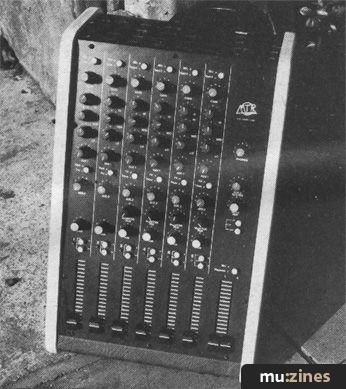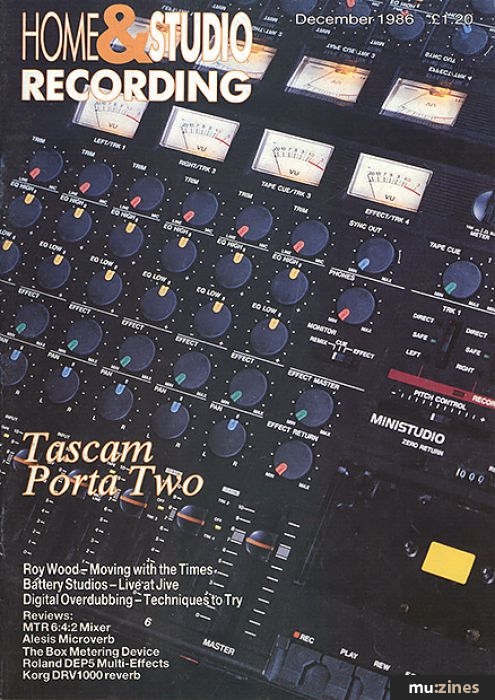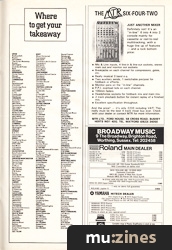Magazine Archive
Home -> Magazines -> Issues -> Articles in this issue -> View
The Next Step | |
MTR 6:4:2Article from Home & Studio Recording, December 1986 | |
A budget 6:4:2 mixer that is neither short on features nor costs the earth.
Once bitten by the recording bug, the first major obstacle to bar your path up the ladder of progress is likely to be the limited facilities offered by the mixer in your cassette multitrack recorder. The MTR 6:4:2 could be a cost-effective way out.

Here at H&SR's editorial offices, we receive a significantly large number of readers' letters enquiring how they should best patch effects into their cassette multitrack recorders and often the only possible answer involves a severe compromise of some sort. Now that digital reverb has become affordable, and given that most of these are mono-in, stereo-out devices, it is no wonder that the available number of channels is soon exhausted. This, together with the fact that several otherwise laudable machines have no proper auxiliary effects send facility eventually leads those who can afford it to add an external mixer to their system. But mixers don't come cheap: most are designed with either PA or more sophisticated recording in mind. It therefore come as a pleasant surprise to find a British firm championing the cause of the underdog by bringing out an affordable mixer specifically designed for use with 4-track cassette and open reel machines. Furthermore, if your machine already has a well equipped 4- or 8-channel mixer section, adding one of these could be the answer if you want to run drum machines and sequenced synths at the same time as you mix.
The way that this mixer is designed, it could completely replace the mixer in your cassette Portatracker (or whatever) but it would be more sensible to find a way to use both together. Recording is not usually a problem as things tend to get added one at a time but at mixdown, the trouble starts. If your tape machine has direct outputs for each channel, you could plug these into the four tape inputs on the MTR and take it from there. If however this is not possible, all is not lost. Some machines have insert points and so you can hi-jack the signal there or, as a last resort, you could just use the MTR mixer to handle just your effects returns and maybe the odd MIDId keyboard and then feed these back into the auxiliary returns or 2-track buss on your cassette machine. Whichever way you choose, there is no cassette multitrack recorder on the market that wouldn't benefit greatly from having one of these little mixers patched into it.
Setting the Scene
MTR originally had a range of mixers built for them under the MTR name by another British firm but they are at pains to point out that this new range of mixers is designed and built in their own factory. Some of the styling aspects are similar but otherwise, this is a new range of products.
Even though this is only a 6:4:2 mixer, it's no toy. The only section missing is metering; it's assumed that your recorder will be equipped with these. The whole thing is built like a full scale studio mixer but, as there are only six channels, it looks rather narrow. However, it has long travel faders, 3-band EQ and a proper monitor section in addition to two auxiliary sends.
Constructionally, the MTR 6:4:2 is simple and solid, sporting steel metalwork and pine end cheeks. The styling is again simple but tidy and clean.
All the connections, with the exception of the phones sockets, are on the rear panel and the power supply is internal so you don't have any little boxes to worry about. Signal levels all conform to the -10dB semi-pro standard and unusually, two headphone outlets are fitted. One of these is in stereo to monitor the main mix output and the other is in mono and connected to the the Aux 1 buss providing a foldback or cue mix. Both of these emerge from the leather look hand rest at the front of the desk.
The Opening Chapters
The six input channels are identical in all respects apart from the monitoring. There are only four sets of monitor controls as the mixer is designed for use with 4-track recorders. Mic and line inputs are selected in the usual way via a latching pushbutton and both the mic and line inputs are on unbalanced jack sockets. The Mic impedance is 4KΩ and the line is 47KΩ, typical values that should match most equipment in common use. The channel input gain is varied by means of the perfectly conventional Gain control and the effect of this is monitored by a peak LED located above the channel fader to warn of impending clipping.
Unusually on a mixer of this price, the EQ is a full 3-band affair with sensibly chosen fixed frequencies of 80Hz, 2kHz and 12kHz. All offer both cut and boost to the tune of 15dB with the bass control managing a generous 18dB: more than you should ever need.
Auxiliary 1 is switchable. It can be used as a pre-fade control for monitoring or as post-fade for controlling effects. When recording and overdubbing, it would almost certainly be set to pre-fade. What this jargon-encrusted term means is that the aux level is not affected by the channel fader so you can set up a comfortable working mix in the monitor headphones and know that fiddling with the channel faders isn't going to mess it up. So what does post-fade imply?
When the switch is selected to post or FX as it is labelled, it performs exactly the same job as Aux 2 which is not switchable. In this case the Aux send is affected by the channel fader but that is just what you want when you are running say an echo unit from it. When you turn down a channel, the echo associated with that channel will go down by the same amount so the balance always remains constant. If instead you run your effects from a pre-fade auxiliary, you might end up turning the lead guitar down after a solo and find that its echo is still coming back through the returns at full volume.
There are no master aux outs on this desk, the Aux 1 s are all mixed together and appear on the Aux 1 socket on the rear panel. Likewise the Aux 2s all appear on the Aux 2 output.
"All six channels have insert points in the form of stereo jacks and these are useful for connecting individual effects or processors into specific tracks."
So far so good. Now we get to the monitor controls. Their job is to let you set up a rough stereo mix of what's already on tape for overdubbing purposes. After all, if you can't hear what's on tape, you can't keep time to it or play in tune with it can you? This feeds the monitor socket on the back panel, which accepts a stereo jack, and also the monitor phones. These monitor controls only work when the channel selector is set to Mic and there's a signal playing off-tape. When the switch is set to line, the tape outputs come through the main channels which would be correct for mixing or bouncing.
The pan controls too are quite standard and, used in conjunction with the routing buttons, these allow you to direct the output of any channel to any of the four tape outputs or the stereo mix out. Slightly unorthodox but nevertheless effective is the method of routing to the stereo L/R mix buss. Both routing buttons are left in their up position which prevents the signal from finding its way to the tape output and simultaneously routes it to the main stereo output. The faders are carbon types with a smooth, positive feel and the panel is calibrated in dBs.
All six channels have insert points in the form of stereo jacks and these are useful for connecting individual effects or processors into specific tracks. For example, you could connect your old flanger pedal into the insert point if you just wanted to flange whatever was on that channel. And remember that both insert points and effects send auxiliaries can be used both on record and on playback.
The Main Plot
After looking at a large studio console, the master section looks a bit on the sparse side but don't be fooled; everything you need is there. The Phones control sets the levels of the phone output monitoring the main stereo mix and the other set of phones is controlled by the setting of the Aux 1 controls.
There is only one aux return, which has its own level control and pan pot, and this may be routed to either the main mix or any of the tape outs by the routing buttons directly below it. Effects may also be returned through the two mixer input channels not used for tape returns. Further down is the Mix/Playback button and when you press this, you know that the job is nearly done. That's because it switches to the output of your stereo recorder and the first time you will want to hear this is when you are checking the final mix to see if it's as good as you thought.
One nice touch is that the two main MR sliders are mounted close together so that controlled fades are easy and these are the same long travel models as used in the input channels.
The last thing to examine is the flexibility of the connection system. As with a full sized mixer you can leave your master stereo recorder plugged in all the time which saves patching, and the main output can feed your stereo hi-fi amp or whatever monitor system you have. The additional monitor output can be fed into virtually any amplification system though I think most home users would just use the phones to monitor. But it's nice to be given the choice.
The Action
So how does it all work? It seems to be accepted that a good mixer is one you don't notice, ie. one that's transparent to the user, and this one takes a bold step in that direction. Separate tape returns would have made life a bit easier as you have to tie up four of the six line inputs, but you can live with repatching if there are only four tracks. (16 would be a different matter.)
The EQ seems to be of the same kind as on the larger MTR desks and does its job more than adequately except for the common failing that it prevents you from doing anything about peaks in the lower mid range. It's the most awkward part of the entire spectrum, especially when you are close miking drums, yet none of the budget mixer builders give it the attention it deserves when it comes to EQ design.
The switchable auxiliary is another sound design feature on a budget mixer and the only problem you might get in this department will be due to the lack of a master send level control. It's perfectly satisfactory if your effects unit has got an input gain control but many seem to do without these days. The same is true if you are using pedals for any of your effects. It doesn't make the system unusable by any means, it just means that you have to alter all the send levels rather than one master which can be a bit of a pain.
Noise isn't a real problem and only rears its ugly head when a lot of mic gain is employed. To be fair, most budget mixers and many of the more expensive ones are little better in this respect; it's a difficulty that can't be cheaply avoided. But for close miking and line inputs, there's no problem.
The Grand Finale
Not only does this mixer vastly expand the flexibility of a modest cassette based home studio, it's also laid out in full sized console format and so is excellent training to anyone going to move up to a full system in the forseeable future. The routing and monitoring is virtually the same as that found on a large studio console, it's just that there's less of it.
Soundwise the mixer is up to scratch within the limits of its fixed 3-band EQ and it could also find uses in larger studios where the main console doesn't have enough channels to cope. There are 101 ways of connecting this mixer into a small system and it offers all the right things for the right price. I could complain that there are no meters, no master aux levels and no sweep EQ but if it had all those things, it would price itself out of the market that needs it the most. If you're feeling the limitations of your system and want to break free from the constraints of a built-in toy mixer, this could be one giant step for you.
The MTR 6:4:2 costs £285 including VAT.
Further details can be obtained from: MTR, (Contact Details).
Also featuring gear in this article
Publisher: Home & Studio Recording - Music Maker Publications (UK), Future Publishing.
The current copyright owner/s of this content may differ from the originally published copyright notice.
More details on copyright ownership...
Review by Paul White
Help Support The Things You Love
mu:zines is the result of thousands of hours of effort, and will require many thousands more going forward to reach our goals of getting all this content online.
If you value this resource, you can support this project - it really helps!
Donations for May 2024
Issues donated this month: 0
New issues that have been donated or scanned for us this month.
Funds donated this month: £0.00
All donations and support are gratefully appreciated - thank you.
Magazines Needed - Can You Help?
Do you have any of these magazine issues?
If so, and you can donate, lend or scan them to help complete our archive, please get in touch via the Contribute page - thanks!










